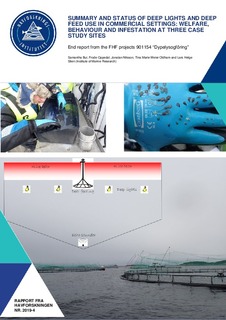| dc.contributor.author | Bui, Samantha | |
| dc.contributor.author | Oppedal, Frode | |
| dc.contributor.author | Nilsson, Jonatan | |
| dc.contributor.author | Oldham, Tina Marie Wier | |
| dc.contributor.author | Stien, Lars Helge | |
| dc.date.accessioned | 2019-05-24T08:49:49Z | |
| dc.date.available | 2019-05-24T08:49:49Z | |
| dc.date.created | 2019-03-07T13:08:03Z | |
| dc.date.issued | 2019 | |
| dc.identifier.uri | http://hdl.handle.net/11250/2598649 | |
| dc.description.abstract | Infective salmon lice are attracted to light and are therefore more abundant near the surface than deep in the cage. Manipulating salmon swimming depth by the use of deep lights and deep feeding could therefore spatially separate fish and lice and reduce infestation rate. This was tested at three different commercial farms: during around a year at the fjordsites Kobbavika and Vindsvik in Rogaland, and during 2 months at the more coastal and exposed Skrubbholmen in Nord-Trøndelag. Control cages were fed at the surface and had deep light only as an anti-maturation management during the winter-spring season, while treatment cages were fed at 7 m depth and had deep lights throughout the period. At Vindsvik, a third group with a lice skirt in addition to deep light and feeding was included. Vertical position of the fish was monitored by echo sounders, environment was profiled daily and lice infestation and fish welfare was assessed at monthly samples. The deep attractor made salmon swim on average 5.5 m deeper at Vindsvik, while the effect was generally small at Kobbavika. When there was a clear temperature stratification temperature preferences overruled the effect of the attractors on swimming depth. Deep light and feeding had no significant effect on lice infestation status or on welfare score. Neither was there an effect of swimming depth on lice infestation rate. However, a halocline with brackish water above was present during much of the study period at both Kobbavika and Vindsvik, and as the infective lice avoid low salinities this may have pushed the lice deeper. Swimming distance from the halocline explained infestation rates better, irrespective of light and feeding regime, and high infestations usually occurred when fish swam near the halocline. It is therefore suggested that spatial separation between salmon and lice should take into account both the environment, salmon preference trade-offs and assumed lice vertical distribution, rather than only swimming depth per se. | |
| dc.description.abstract | Summary and status of deep lights and deep feed use in commercial settings: welfare, behaviour and infestation at three case study sites — End report from the FHF projects 901154 “Dypelysogfôring” | |
| dc.language.iso | eng | |
| dc.publisher | Havforskningsinstituttet | |
| dc.relation.ispartof | Rapport fra havforskningen | |
| dc.relation.ispartofseries | Rapport fra havforskningen | |
| dc.relation.uri | https://www.hi.no/hi/nettrapporter/dypelysogforing_kunnskapssammenstilling_sluttrapport.docx | |
| dc.title | Summary and status of deep lights and deep feed use in commercial settings: welfare, behaviour and infestation at three case study sites — End report from the FHF projects 901154 “Dypelysogfôring” | |
| dc.type | Research report | |
| dc.description.version | publishedVersion | |
| dc.source.pagenumber | 33 | |
| dc.source.issue | 2019 - 4 | |
| dc.identifier.cristin | 1682908 | |
| dc.relation.project | Fiskeri- og havbruksnæringens forskningsfond: 901154 | |
| dc.relation.project | Havforskningsinstituttet: 14597-02 | |
| dc.relation.project | Fiskeri- og havbruksnæringens forskningsfond: 901243 | |
| cristin.unitcode | 7431,14,0,0 | |
| cristin.unitname | Dyrevelferd | |
| cristin.ispublished | true | |
| cristin.fulltext | original | |
